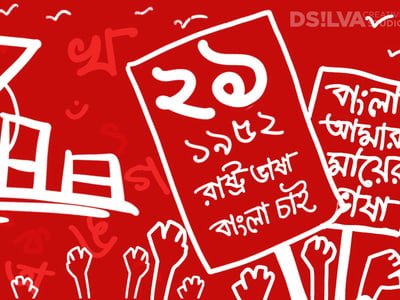The recent protests that have come to light since the Citizenship Amendment Act has been passed have instigated me to think about our country, its history, its diversity and its politics, especially since independence. While some political parties do want to divide its citizens through identities of religion and caste thereby homogenising the “culture” of India, categories of identity, which might be vested with powers of division, often end up integrating people in ways that are not outwardly visible. Language is one such medium through which communities across religions, countries, castes, classes, genders and ethnicities can find commonalities, either through their present active usage, or through their common historical roots. On 21st of February each year, the spirit of unity in diversity is celebrated through the International Mother Language Day across the world, since UNESCO declared the same on 17th November 1999. However, its formal recognition only happened in the year 2002.

The obvious feminist criticism of the use of such gender specific term “mother” language or “mother” tongue would be the patriarchal subjugation insidiously placed within it. Sources inform, that the etymology of the term “mother” tongue and consequently “mother” language is due to the care work mothers put in or are expected to put in, in the process of child rearing. While this could be an acknowledgement of the unpaid care work women do as primary caregivers, it could also act as a metaphor to glorify their care work, indirectly imposing the burden of teaching native languages to children. However, keeping in mind the feminist critique, we still should try to understand why the International Mother Language Day is crucial and a reminder to preserve diversity.
Although the day does have a tragic past to be commemorated, its intentions have travelled across space and time to acquire new meanings of peace and solidarity. The history of the day can be traced back to Bangladesh and its Bengali Language Movement which was organised to fight for linguistic and cultural rights. The day has a bloody past of its own, where students who were protesting were brutally murdered by state forces like the police. This day is observed not simply to remember their martyrship but also to remind everyone about the heterogeneity of cultures and the need to conserve their differences.
History
Bangladesh was a part of present India till 1947. It was ruled by the exploitative colonial government and later was subjected to partitioning itself on grounds of difference in religion. The present Pakistan was called ‘West Pakistan’ and Bangladesh was called ‘East Pakistan’. Post the first partition in 1947 however, Bangladesh was still dominated and governed mostly by the Western parts of the new state of Pakistan. Decisions about the state and its authorities were all made by the West Pakistani officials.

Although the Partition of 1947 was arbitrarily made on grounds of religious difference (Hindu-Muslim), the cultural, linguistic and ethnic complexities continued to prevail in both the West and East Pakistan. And hence, Bangladesh, then East Pakistan, could not simply submit to the homogenising techniques of the West Pakistan authority. One of the major factors that distinguished the two were their local languages. While the Western part of Pakistan used Urdu, East Pakistan used Bangla or Bengali as their language for communication.
ON 21ST FEBRUARY 1952, THE PROTESTS REACHED ITS PEAK AND THE THEN GOVERNMENT OF PAKISTAN ENFORCED MEASURES THAT PROHIBITED THE GATHERING OF MORE THAN 3 PEOPLE, QUITE LIKE SECTION 144 IN INDIA WHICH WAS REPEATEDLY IMPOSED IN THE RECENT ANTI CAA-NRC-NPR PROTESTS.
The differences in the languages were respected until the government, dominated by the West Pakistani officials decided in an education summit in 1947, declared that Urdu be the only official language to be taught and used in educational institutions, like schools. Bangla or Bengali was also removed from the official currency and stamps and as a subject to be taught in schools in the newly formed nation state of Pakistan.
The formation of a nation-state does demand homogeneity in the form of “National Language”, “National Religion”, “National Bird, City etc.” in order to establish their “unity” as a country. However, modern day nations, which have a complex and diverse past cannot be unified coercively through such mandates. There has always been resistance against such attempts to erase histories. For example, in the case of India, there have been multiple attempts to coerce Hindi as a language medium, especially in the southern and eastern parts of the country, which have various native languages of their own.
Resistance
The efforts of making Urdu the dominant language for both parts of Pakistan met with serious forms of resistanc
